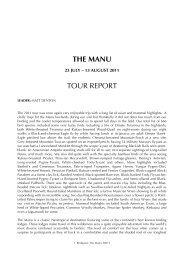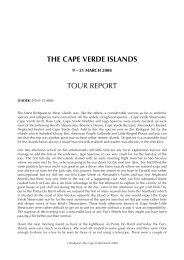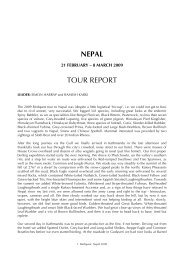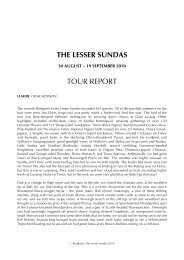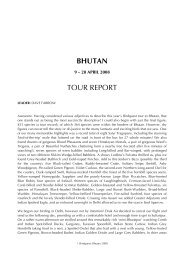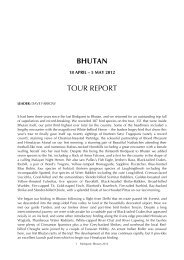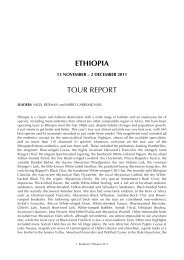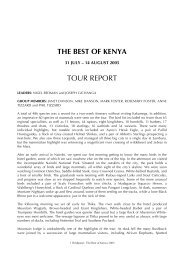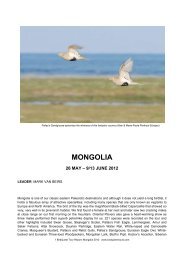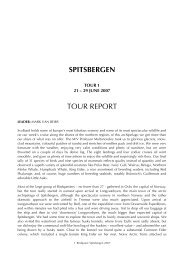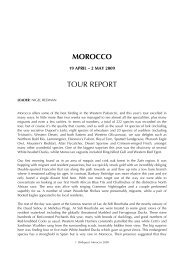Download Full Tour Report 3262kb - Birdquest
Download Full Tour Report 3262kb - Birdquest
Download Full Tour Report 3262kb - Birdquest
You also want an ePaper? Increase the reach of your titles
YUMPU automatically turns print PDFs into web optimized ePapers that Google loves.
Spot-winged Antshrike Pygiptila stellaris: Seen at São Gabriel and at the Anavilhanas jungle lodge.<br />
An interesting species that behaves like an antwren picking about in dead leaves and vine<br />
tangles and indeed has the structure of an antwren as well.<br />
Rufous-tailed Antwren Myrmotherula erythrura: Several seen on the west bank at São Gabriel.<br />
Brown-bellied Antwren Myrmotherula gutturalis: Several pairs seen near the INPA Tower and others<br />
in the Virua NP. A dead leaf specialist found in mixed flocks this species replaces the<br />
following species east of the Rio Negro.<br />
Stipple-throated Antwren Myrmotherula haematonota: Several pairs seen on the west bank at São<br />
Gabriel.<br />
Pygmy Antwren Myrmotherula brachyura: Numerous throughout the trip.<br />
Yellow-throated Antwren Myrmotherula ambigua: A canopy species that can prove a challenge to<br />
see well. We all eventually saw this lovely little antwren along the Abacaxi Trail near São<br />
Gabriel. An Imerí endemic that replaces Sclater’s Antwren M. sclateri north of the<br />
Amazon<br />
Cherrie’s Antwren Myrmotherula cherriei: After failing to find this species along the Igarapé-Açu it<br />
was good to find it to be numerous in the Virua NP where we saw up to five birds at<br />
close quarters. Having been considered an Imerí endemic this species has been found to<br />
be rather more widespread in campinas and white sand forests. Named after George K.<br />
Cherrie (1865-1948), an American ornithologist.<br />
Klages’s Antwren Myrmotherula klagesi: Abundant in the Anavilhanas. This Igapo forest specialist<br />
was thought to occur only in the Anavilhanas and at its type locality, on the Rio Tapajós.<br />
However, it too has now been found along the Solimões, the Lower Rio Negro, the Rio<br />
Branco and the Madeira.<br />
White-flanked Antwren Myrmotherula axillaris: A common species in sub-canopy flocks seen from<br />
Manaus to São Gabriel. Note that this species is undergoing taxonomic revision.<br />
Long-winged Antwren Myrmotherula longipennis: Several pairs seen in mixed-species flocks.<br />
Grey Antwren Myrmotherula menetriesii: Commonly encountered throughout the trip.<br />
Leaden Antwren Myrmotherula assimilis: We found a nice pair and heard many others of this river<br />
island specialist in the Anavilhanas Archipelago.<br />
Dot-winged Antwren Microrhopias quixensis: Several seen in the Virua NP. This species is named<br />
after the type locality; the Rio Quijos in Ecuador.<br />
Banded Antbird Dichrozona cincta: A single bird was taped in and superb views enjoyed by all. An<br />
odd and highly disjunct population of this species that is found mainly south of the<br />
Amazon.<br />
Spot-backed Antwren Herpsilochmus dorsimaculatus: An abundant species seen in most canopy<br />
flocks. Although tricky to get good views of this bird we all managed to do so near São<br />
Gabriel in stunted woodlands.<br />
Southern White-fringed Antwren Formicivora grisea: Heard at the Lajes campina and very common<br />
in Roraima.<br />
Ash-winged Antwren Terenura spodioptila: Seen and heard in a number of flocks.<br />
Grey Antbird Cercomacra cinerascens: We heard this bird almost daily, but managed to see it at São<br />
Gabriel.<br />
Dusky Antbird Cercomacra tyrannina: A very common species. We saw two distinct races during our<br />
trip; the saturatior form along the Cucui Road and the nominate form along the Moises<br />
Trail on the west bank of the Rio Negro.<br />
Willis’s Antbird Cercomacra laeta: A pair seen in Virua NP where considered common.<br />
Rio Branco Antbird Cercomacra carbonaria: In gallery woodlands and scrub with vine tangles must<br />
be considered common in Roraima. We even managed to find several pairs in a village<br />
along the Rio Uracoaera.<br />
Black-faced Antbird Myrmoborus myotherinus: A pair with young seen at Anavilhanas.<br />
White-browed Antbird Myrmoborus leucophrys: A number heard in Virua NP.<br />
Ash-breasted Antbird Myrmoborus lugubris: We had good views of a male in the Anavilhanas. This is<br />
also a river island specialist, restricted to Igapo and river islands.<br />
20 <strong>Birdquest</strong>: Amazonian Brazil 2011




